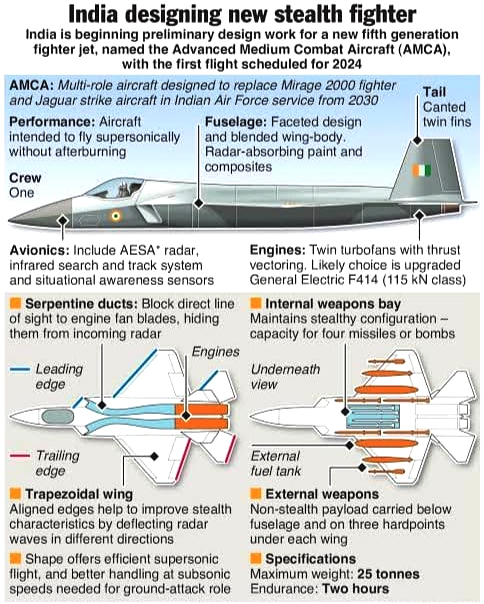AMCA: India Designing New Stealth Fighter - Finalization of the CDR by Early 2022

Saturday, November 13, 2021 | Chimniii Desk
Key Highlights
- Girish S. Deodhare, Program Director (Combat Aircraft) & Director General, ADA, also stated that the LCA AF Mk2 and AMCA programmes are on track.
- The LCA AF Mk2 programme has completed all critical design review activities and is scheduled to roll out in 2022.
- According to the Air Force chief, the fighter jet will blend cutting-edge technologies into its airframe, making it a cutting-edge, state-of-the-art fighter jet comparable to any other in its class worldwide.
- Additionally, the Air Force Chief lauded the effective conclusion of the joint Indo-French exercise, which featured both Indian and French Rafale fighter jets.
Advertisement

Pic Credit: Drishi IAS
R Madhavan, Chairman and Managing Director of Hindustan Aeronautics Limited, confirmed that following the conclusion of the preliminary design review (PDR) of India's 5.5Gen AMCA Program in December 2020 in collaboration with ADA, the critical design review (CDR) will be completed by early 2022, paving the way for the rollout of a prototype aircraft by the end of 2023 and first flight in 2024.
Girish S. Deodhare, Program Director (Combat Aircraft) & Director General, ADA, also stated that the LCA AF Mk2 and AMCA programmes are on track. The LCA AF Mk2 programme has completed all critical design review activities and is scheduled to roll out in 2022. The first flight is scheduled to take place in 2023.
Deodhare noted that the AMCA programme is making significant progress toward CDR, which is scheduled for early next year, following the completion of Preliminary Design Review.
India's 5th-Generation Fighter Jet Will Utilize 6th-Generation Technology
Advertisement

The IAF's AMCA Project, which is being developed by the Aeronautical Development Agency (ADA, the DRDO's aerial research section), is projected to produce a twin-engine multirole stealth fighter aircraft within the next five years.
According to the Air Force chief, the fighter jet will blend cutting-edge technologies into its airframe, making it a cutting-edge, state-of-the-art fighter jet comparable to any other in its class worldwide.
While remaining coy, Ex-IAF cheif RKS Bhadauria stated that the military is looking forward to the aircraft incorporating 6th-generation characteristics, bearing in mind the aircraft's future development and usability by the IAF.
“OUR PRESENT VISION IS TO INCORPORATE THE LATEST TECHNOLOGIES AND SENSORS IN OUR 5TH-GENERATION AIRCRAFT,” HE SAID.
He also admitted that India began the effort later than the majority of other countries, emphasising the importance of incorporating higher-generation technologies.
“WE STARTED THE WORK ON FIFTH-GENERATION AIRCRAFT A LITTLE LATE. SO TECHNOLOGIES AND SENSORS CONTEMPORARY TO THAT PERIOD OF DEVELOPMENT WOULD BE ADDED INTO FIFTH-GENERATION FIGHTERS.”
The Indian aviation manufacturing industry, dominated by state-owned Hindustan Aeronautics Limited, has struggled to keep up with the development and production of the Tejas Mk-1 and Mk-1A, and is now concentrating on the prototype and testing of the Tejas Mk-2 (an improvised single-engine fourth/4++ generation aircraft based on the Mk-1A).
The expertise obtained via the development of the Tejas project is believed to have prepared the Indian designers for a further jump towards stealth technology.
Additionally, the Air Force Chief lauded the effective conclusion of the joint Indo-French exercise, which featured both Indian and French Rafale fighter jets.
He stated that when the IAF got the Rafale aircraft, the primary objective was to operationalize and integrate it into the existing combat fleet. The service accomplished this in a short period of time, and the joint exercise, which included additional fighter jets such as the Su-30MKI and Mirage-2000I, demonstrated integration and interoperability in action.
Cooperation with France has also given the AMCA project a much-needed boost in terms of its powerplant, since it is expected that the aircraft will use an indigenous Kaveri engine, the development of which will be helped by the French company SAFRAN.
Advertisement